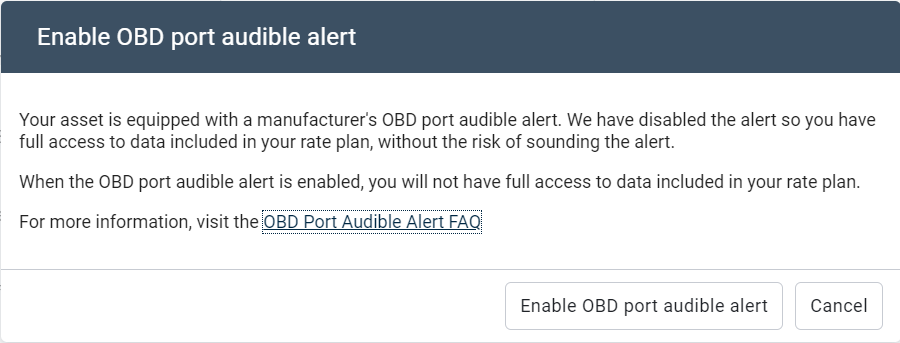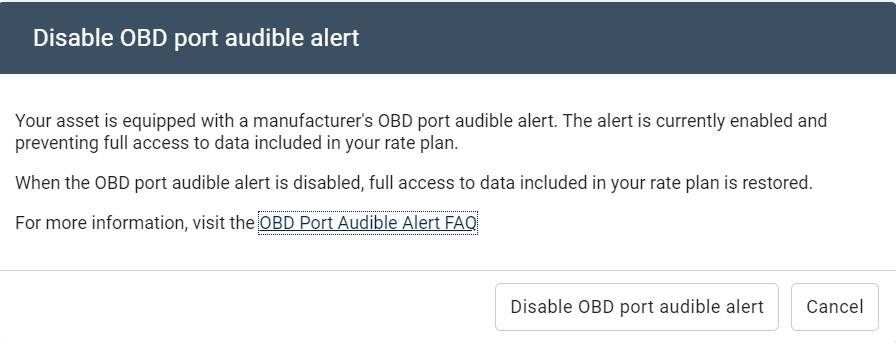OBD Port Audible Alert FAQ
FAQ
0 mins to read
Browse frequently asked questions about the On-Board Diagnostic port and telematics devices. While OBD port alerts are designed to detect undesired device installations, they can also be triggered by intentional device installations that are necessary for fleet operations. This FAQ answers common questions about verifying whether vehicles have an OBD alert and enabling and disabling the alert in your vehicle.
FAQs
December 2022
OBD port audible alert
Some vehicles sound an alert if any On-Board Diagnostic (OBD) third-party telematics device makes a data request via the OBD port while the vehicle is both locked and the ignition is off. While this alert is designed to detect undesired device installations, it can also be triggered by intentional device installations that are necessary for fleet operations. Given that this alert interferes with the intended operations of the telematics device, the version 9 device disables it by default as of firmware version x.27.x on confirmed vehicles.
Should a user choose to re-enable the alert, the telematics device will request less vehicle data to avoid triggering the alert. For electric vehicles (EVs), re-enabling the alert may result in loss of charging data and delay of driving data.
While a vehicle cannot be fully operated via OBD alone, actions such as locking/unlocking doors, rolling down windows, and starting the engine may be possible. The specific abilities of the telematics device is governed according to your service plan.
FAQs
Which vehicles are likely to have an OBD alert?
Only some vehicles have a confirmed OBD alert. The following list is non-exhaustive, and the OBD alert may not apply to all model years.
Vehicle make | OBD alert disabled by the version 9 telematics device: Full data access | OBD alert not disabled by the version 9 telematics device: No data collected during charging state (when version 9 device installed in a vehicle with the OBD alert enabled) |
Audi | A3 eTron 2016+ Q6 eTron 55 Quattro | Q4 e-tron |
BMW | 225 XE PHEV 5 Series PHEVs 7 Series PHEVs i3 2014-2020 X Series PHEVs | |
CUPRA | Born | |
Škoda | Enyak | |
VW | eGolf Golf GTE Passat GTE | ID.3 ID.4 |
Can the telematics device cause the OBD alert to sound?
If the alert is not disabled upon installing the telematics device, the version 9 device (with firmware version x.27.x+) will disable the alert by default for those indicated models above. For those models where the OBD alert is enabled at the time of version 9 telematics device install, and not disabled by default, data collection during charging will not be available. In both scenarios, this allows the device to provide maximum data access according to your service plan without risk of sounding the alert.
There is a risk that the OBD alert will sound on the above EVs with version 7 or version 8 devices, and on version 9 devices with firmware version less than x.27.x.
There remains a risk that the OBD alert will sound on any other vehicle where the OBD alert is not yet confirmed.
✱ NOTE: Should the version 9 device be installed in an EV and charged prior to the vehicle being started (ignition on), there is a risk that the alert will sound. Please follow the standard device installation instructions.
How can I verify if a vehicle has an OBD alert?
Verifying the presence of an OBD alert — Fleet Management Application Portal
1 | Navigate to Engine & Maintenance > Engine and Device … > Measurements from the main menu. Select a date period that includes the last time this vehicle was driven, and select your vehicle(s) of interest. |
2 | Use the Diagnostics field to search for Generic OBD port alert status (0 = unknown / 1 = enabled / 2= disabled / 3 = not available), and click Apply changes. |
| |
3 | Review the search results and follow the guidelines below to determine if the vehicle has an OBD alert:
|
Verifying the presence of an OBD alert — API
Via StatusData, retrieve value DiagnosticObdPortAlertStatusId (StatusData ID) and follow the guidelines below to determine if the vehicle has an OBD alert:
How can I enable the OBD Alert?
If the alert is not disabled upon installing the telematics device, the version 9 device (with firmware version x.27.x+) will disable the alert by default for those models indicated in Which vehicles are likely to have an OBD alert?. After you have confirmed an OBD alert is present and has been disabled, follow the steps below to re-enable the OBD alert. For more information on how to verify the presence of an OBD alert, follow the steps outlined in How can I verify if a vehicle has an OBD alert?.
✱ NOTE: For EVs, an enabled OBD alert may result in loss of charging data and delay of driving data. Please contact your Partner to determine whether a different service plan may be more appropriate in this case.
Enabling an OBD alert — Fleet Management Application Portal
1 | Navigate to Vehicles & Assets, and select the vehicle for which you want to re-enable the OBD alert. In the top navigation row select Settings. |
2 | In the Advanced section, determine if the OBD port audible alert option is toggled off. ! IMPORTANT: OBD port audible alert: does not appear if the OBD alert is unknown, or when it does not have one. To verify the presence of the OBD alert, see How can I verify if a vehicle has an OBD alert?.
|
3 | Click the OBD port audible alert toggle to on and you will see the following message: |
| |
4 | Click Enable OBD port audible alert to complete the request. Changes typically take place with the next trip. |
5 | Click the Save button at the top left. |
To verify that the OBD alert was successfully enabled, follow the instructions for How can I verify if a vehicle has an OBD alert? and confirm the value is 1.
Enabling an OBD alert — API
Call Set against an object of type Device (GO9), with the obdAlertEnabled property set to true. Changes typically take effect the next time the vehicle’s ignition is turned on.
To verify that the OBD alert was successfully enabled, follow the instructions for How can I verify if a vehicle has an OBD alert? and confirm the value is 1.
How can I disable the OBD alert?
If the alert is not disabled upon installing the telematics device, the version 9 device (with firmware version x.27.x+) will disable the alert by default for those vehicles indicated in Which vehicles are likely to have an OBD alert?. Should it be re-enabled, you have the option to disable it again. For those vehicles indicated as OBD alert not disabled by the version 9 telematics device in Which vehicles are likely to have an OBD alert?, it is currently not possible to disable the OBD alert by the GO device. To disable the OBD alert in this case, please contact the authorized dealer of your vehicle.
✱ NOTE: If the OBD alert is disabled, the device will provide full data access according to its service plan.
If the OBD alert has been enabled by completing the steps above, the following instructions can be used to disable the alert.
Disabling an OBD alert — Fleet Management Application Portal
1 | Navigate to Vehicles & Assets in the main menu, and select the vehicle for which you want to disable the OBD alert. In the top navigation row select Settings. |
2 | In the Advanced section, determine if the OBD port audible alert option is toggled on.
! IMPORTANT: OBD port audible alert does not appear if the OBD Alert is unknown, or when it does not have one. To verify the presence of the OBD Alert, see How can I verify if a vehicle has an OBD alert?. |
3 | Click the OBD port audible alert toggle to on and you will see the following message:
|
4 | Click Disable OBD port audible alert to complete the request. Changes typically take place with the next trip. |
5 | Click the Save button at the top left. |
To verify that the OBD alert was successfully enabled, follow the instructions for How can I verify if a vehicle has an OBD Alert? and confirm the value was 2.
Disabling an OBD alert — API
Call Set against an object of type Device (GO9), with the obdAlertEnabled property set to false. Changes typically take effect the next time the vehicle’s ignition is turned on, and is driven.
To verify that the OBD alert was successfully disabled, follow the instructions for How can I verify if a vehicle has an OBD alert? and confirm the value was 2.




